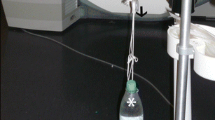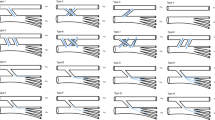Abstract
Objectives
To demonstrate the bifid configuration of the flexor digitorum profundus (FDP) and flexor pollicis longus (FPL).
Methods
In the first part of this study, 20 digits from 4 cadaver hands were dissected and analyzed using anatomical and histological slices. The second part of the study was carried out over a 12-month period starting in August 2018. It was a prospective US imaging study of 300 digits from 30 healthy participants performed by two radiologists in a double-blinded manner. This study focused on two items: tendon shape and whether a central septum separated the two hemitendons. Descriptive statistics were calculated along with the inter-rater reliability.
Results
In 100% (300/300) of fingers and thumbs, the FDP and FPL tendons were made up of two parallel bundles arranged side by side, with a central vertical septum between these two hemitendons, starting at the head of the proximal phalanx (PP) and continuing distally. This central septum was always present starting at the proximal third of PP for the FDP of the index, middle, and ring fingers. The septum was more difficult to identify in the thumb and little finger. Cohen’s kappa indicated near perfect agreement when all digits were considered together (≥ 0.9), and substantial agreement for the thumb (0.71) and for the little finger (0.82).
Conclusions
With US imaging, the bifascicular nature of the FDP and FPL tendons is easy to see, as these tendons have a double-barreled configuration starting at the head of the proximal phalanx.
Key Points
•Analysis of anatomical slices of the hand tendons found a bifascicular appearance of the flexor digitorum profundus and flexor pollicis longus tendons starting at the head of the proximal phalanx.
•This distinct feature of two hemitendons arranged side by side was seen in 100% of tendons we examined with US. It is associated with a vertical central septum that causes anisotropy.
•Awareness of this “forgotten” anatomical detail has practical implications when interpreting images generated by latest-generation US systems and during surgery on hand flexor tendons.






Similar content being viewed by others
Abbreviations
- FDP:
-
Flexor digitorum profundus
- FDS:
-
Flexor digitorum superficialis
- FPL:
-
Flexor pollicis longus
- MCP:
-
Metacarpophalangeal joint
- PIP:
-
Proximal interphalangeal joint
- DIP:
-
Distal interphalangeal joint
- PP:
-
Proximal phalanx
- MP:
-
Middle phalanx
- DP:
-
Distal phalanx
References
Netter FH (2019) Upper limb. In: Atlas of Human Anatomy, 7th edn. ELSEVIER, Philadelphia, p plates, pp 433–450-451
Drake RL, Vogl AW, Mitchell AWM (2020) Upper Limb. In: Gray’s anatomy for students, 4th edn. Elsevier, Philadelphia, pp 766–795
Moses KP, Banks JC, Nava PB, Petersen DK (2013) Upper limb. In: Atlas of clinical gross anatomy, 2nd edn. ELSEVIER, Philadelphia, pp 248–282
Lapegue F, Andre A, Brun C et al (2015) Traumatic flexor tendon injuries. Diagn Interv Imaging 96:1279–1292
Schuenke M, Schulte E, Schumacher U (2016) Wrist and hand. In: Gilroy AM, MacPherson BR (eds) Atlas of anatomy, 3rd edn. Thieme Medical Publishers, New York, pp 338–358
Putz R, Pabst R (2006) Muscles of the upper limb. In: Sobotta J (ed) Atlas of human anatomy, head, neck, upper limb, 14th edn. Elsevier, Munich, p 209
Testut L, Latarjet A (1948) Muscles de la main. In: Traité d’Anatomie Humaine, 9th edn. G.Doin, p 1089
Winslow J (1732) Les muscles qui meuvent les doigts de la main. In: Exposition anatomique de la structure du corps humain. Laurent Charles D’Houry Fils, Paris, pp 319–320
Boyer A (1797) De la myologie. In: Traité complet d’anatomie ou description de toutes les parties du corps humain. Migneret, Paris, pp 294–300
Bichat X (1812) Appareils de la locomotion des muscles et de leurs dépendances. In: Traité d’anatomie descriptive. Buisson, Paris, pp 237–240
Cruveilher J (1843) Myologie : Fléchisseurs profonds des doigts. In: Traité d’anatomie descriptive. Béchet, Paris, pp 270–273
Poirier P, Charpy A (1895) Myologie. In: Traité d’anatomie humaine. Bataille et Cie éditeurs, Paris, pp 115–117
Bourgery J-M (1831) Sujet complet de myologie. In: Traité complet de l’anatomie de l’homme comprenant la médecine opératoire. Dalauney, Paris, p Plate 123
Bommier A, McGuire D, Boyer P, Rafee A, Razali S, Oberlin C (2018) Results of heterodigital flexor digitorum profundus hemi-tendon transfer for 23 flexor tendon injuries in zones 1 or 2. J Hand Surg Eur Vol 43:487–493
Elliot D, Khandwala AR, Ragoowansi R (2001) The flexor digitorum profundus “demi-tendon”--a new technique for passage of the flexor profundus tendon through the A4 pulley. J Hand Surg Br 26:422–426
Durand S, Oberlin C, Macquillan A (2010) FDP to FDP hemi-tendon transfer--a new technique for delayed repair of the flexor digitorum profundus in zones I and II of the finger. J Hand Surg Eur Vol 35:677–678
Leddy JP, Packer JW (1977) Avulsion of the profundus tendon insertion in athletes. J Hand Surg Am 2:66–69
McCallister WV, Ambrose HC, Katolik LI, Trumble TE (2006) Comparison of pullout button versus suture anchor for zone I flexor tendon repair. J Hand Surg Am 31:246–251
Murphy BA, Mass DP (2005) Zone I flexor tendon injuries. Hand Clin 21:167–171
Brustein M, Pellegrini J, Choueka J, Heminger H, Mass D (2001) Bone suture anchors versus the pullout button for repair of distal profundus tendon injuries: a comparison of strength in human cadaveric hands. J Hand Surg Am 26:489–496
Acknowledgments
The authors acknowledge Joanne Archambault, Ph.D., for editorial assistance.
Funding
The authors state that this work has not received any funding.
Author information
Authors and Affiliations
Corresponding author
Ethics declarations
Guarantor
The scientific guarantor of this publication is Dr. Franck LAPEGUE.
Conflict of interest
The authors of this manuscript declare no relationships with any companies whose products or services may be related to the subject matter of the article.
Statistics and biometry
Dr. Ezin Jocelyn Akakpo, M.D., expert in statistics, kindly provided statistical advice for this manuscript.
No complex statistical methods were necessary for this paper.
Informed consent
Written informed consent was obtained from all subjects (patients) in this study.
Approval from the institutional animal care committee was not required (no animal subject in this study).
Ethical approval
Institutional Review Board approval was obtained.
Methodology
• prospective
• observational
• performed at one institution
Additional information
Nota bene: The references corresponding to ancient French anatomy books can be consulted on the website of the « bibliothèque nationale de France » (https://gallica.bnf.fr).
Publisher’s note
Springer Nature remains neutral with regard to jurisdictional claims in published maps and institutional affiliations.
Rights and permissions
About this article
Cite this article
Lapegue, F., Tiercelin, M., Siala, M. et al. Bifascicular nature of the flexor digitorum profundus and flexor pollicis longus tendons: forgotten anatomical characteristics rediscovered with US imaging. Eur Radiol 30, 6653–6662 (2020). https://doi.org/10.1007/s00330-020-07048-5
Received:
Revised:
Accepted:
Published:
Issue Date:
DOI: https://doi.org/10.1007/s00330-020-07048-5




